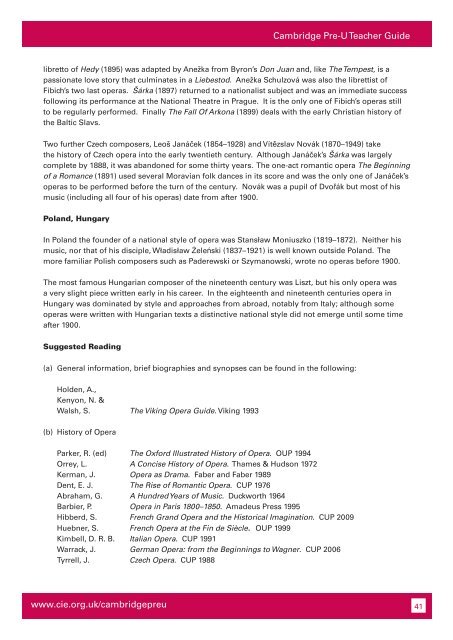Teacher's Guide Cambridge Pre-U MUSIC Available for teaching ...
Teacher's Guide Cambridge Pre-U MUSIC Available for teaching ...
Teacher's Guide Cambridge Pre-U MUSIC Available for teaching ...
Create successful ePaper yourself
Turn your PDF publications into a flip-book with our unique Google optimized e-Paper software.
<strong>Cambridge</strong> <strong>Pre</strong>-U Teacher <strong>Guide</strong><br />
libretto of Hedy (1895) was adapted by Anežka from Byron’s Don Juan and, like The Tempest, is a<br />
passionate love story that culminates in a Liebestod. Anežka Schulzová was also the librettist of<br />
Fibich’s two last operas. Šárka (1897) returned to a nationalist subject and was an immediate success<br />
following its per<strong>for</strong>mance at the National Theatre in Prague. It is the only one of Fibich’s operas still<br />
to be regularly per<strong>for</strong>med. Finally The Fall Of Arkona (1899) deals with the early Christian history of<br />
the Baltic Slavs.<br />
Two further Czech composers, Leoš Janáek (1854–1928) and Vítzslav Novák (1870–1949) take<br />
the history of Czech opera into the early twentieth century. Although Janáek’s Šárka was largely<br />
complete by 1888, it was abandoned <strong>for</strong> some thirty years. The one-act romantic opera The Beginning<br />
of a Romance (1891) used several Moravian folk dances in its score and was the only one of Janáek’s<br />
operas to be per<strong>for</strong>med be<strong>for</strong>e the turn of the century. Novák was a pupil of Dvoák but most of his<br />
music (including all four of his operas) date from after 1900.<br />
Poland, Hungary<br />
In Poland the founder of a national style of opera was Stansław Moniuszko (1819–1872). Neither his<br />
music, nor that of his disciple, Władisław eleski (1837–1921) is well known outside Poland. The<br />
more familiar Polish composers such as Paderewski or Szymanowski, wrote no operas be<strong>for</strong>e 1900.<br />
The most famous Hungarian composer of the nineteenth century was Liszt, but his only opera was<br />
a very slight piece written early in his career. In the eighteenth and nineteenth centuries opera in<br />
Hungary was dominated by style and approaches from abroad, notably from Italy; although some<br />
operas were written with Hungarian texts a distinctive national style did not emerge until some time<br />
after 1900.<br />
Suggested Reading<br />
(a) General in<strong>for</strong>mation, brief biographies and synopses can be found in the following:<br />
Holden, A.,<br />
Kenyon, N. &<br />
Walsh, S. The Viking Opera <strong>Guide</strong>. Viking 1993<br />
(b) History of Opera<br />
Parker, R. (ed) The Ox<strong>for</strong>d Illustrated History of Opera. OUP 1994<br />
Orrey, L. A Concise History of Opera. Thames & Hudson 1972<br />
Kerman, J. Opera as Drama. Faber and Faber 1989<br />
Dent, E. J. The Rise of Romantic Opera. CUP 1976<br />
Abraham, G. A Hundred Years of Music. Duckworth 1964<br />
Barbier, P. Opera in Paris 1800–1850. Amadeus <strong>Pre</strong>ss 1995<br />
Hibberd, S. French Grand Opera and the Historical Imagination. CUP 2009<br />
Huebner, S. French Opera at the Fin de Siècle. OUP 1999<br />
Kimbell, D. R. B. Italian Opera. CUP 1991<br />
Warrack, J. German Opera: from the Beginnings to Wagner. CUP 2006<br />
Tyrrell, J. Czech Opera. CUP 1988<br />
www.cie.org.uk/cambridgepreu 41
















